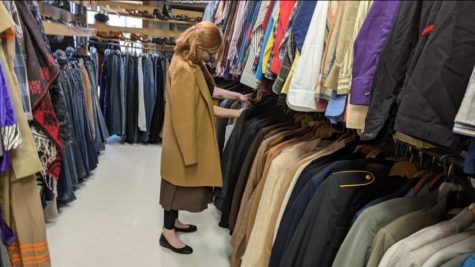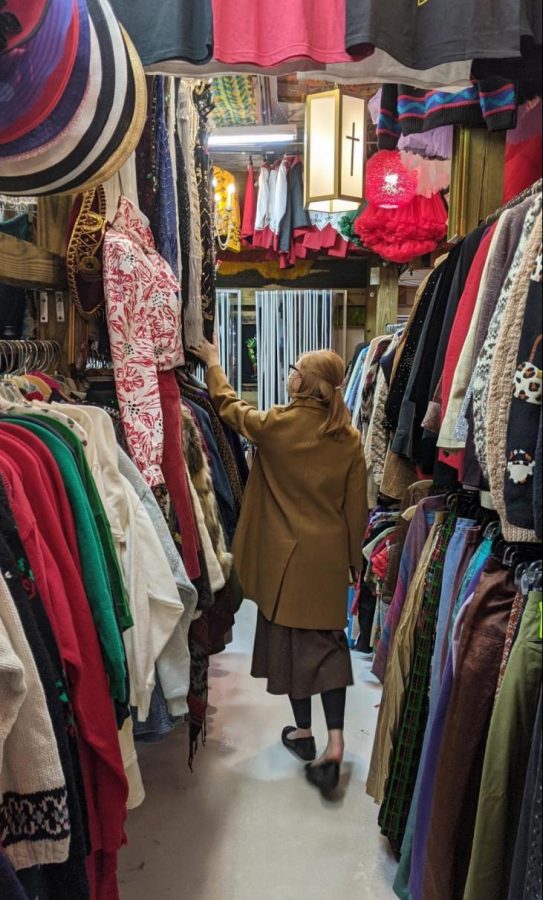To Thift or Not to Thrift?
It’s common knowledge that fashion is changing. This is a known fact and a constant one for most of human history. Fashion is ever-changing and made up of trends that never stick around long. However, the way we get fashion has been standard for a relatively long amount of time. “Fast fashion” is a buzz word for the way most fashion these days is made.
Big companies like Forever 21 or Old Navy make clothes in a factory somewhere across the world, and they make it fast and cheap. They send these garments to stores, we buy it, we wear it a couple of times and then we throw out the clothing all together. This cycle repeats itself, producing constant waste, underpaying workers, and destroying the hand sewing and tailoring industries. This process rose in popularity in the early 2000’s and has been the default of the clothing industry ever since.
This vicious cycle of waste has caused a “sustainability crisis” in the fashion community. Recently, it has been on full display as people look for ways to help the environment and cut back their negative effects on the planet. A popular choice has been to shop at secondhand, vintage or local thrift stores; Goodwill or online thrift stores and resale platforms like Depop or thredUP also offer options.
This new wave of secondhand shopping has both influenced and been influenced by popular culture. Many online trends like Instagram moodboards encourage secondhand shopping with their vintage aesthetics and old-fashioned pictures.
This is also a reason for the rise in social media influencers who use their platforms to educate people on and showcase the benefits of secondhand fashion or making your own clothes with popular YouTubers like Rachel Maksy (over 650,000 subscribers), Bernedette Banner (almost 1 million subscribers) and Ashley aka @bestdressed (3.64 million subscribers).
This new trend of secondhand shopping is helpful not just to the environment, but also to the garment workers of the fast fashion industry. Workers who make clothes overseas for companies in the U.S. have few rights and are paid staggeringly small wages. They also are forced to work many hours in poorly managed health conditions. When consumers start giving their money to brands who pay their workers well or stop supporting the ones who don’t, this encourages companies to raise wages and manage conditions in a more humane way.
 Fashion is a huge part of my life and has always been a way for me to express myself. It means a lot to me that I can tell the world something about myself without them having to ask. I use fashion to express my interests, style and opinions every day. Whether it’s a skirt or a pair of shoes, what I wear is always intentional. Even my participation in cosplay is a way I use my clothing to express something about myself. I find it fascinating how trends have changed over the years, but fashion has been a thing ever since clothing was. I love how fashion can set you apart or make you blend in so seamlessly.
Fashion is a huge part of my life and has always been a way for me to express myself. It means a lot to me that I can tell the world something about myself without them having to ask. I use fashion to express my interests, style and opinions every day. Whether it’s a skirt or a pair of shoes, what I wear is always intentional. Even my participation in cosplay is a way I use my clothing to express something about myself. I find it fascinating how trends have changed over the years, but fashion has been a thing ever since clothing was. I love how fashion can set you apart or make you blend in so seamlessly.
I stumbled upon my love of secondhand fashion by accident when I started dressing in vintage clothing a couple years ago like my mother occasionally did. I started by mostly wearing brand new reproductions, but fell head over heels for authentic vintage clothing the instant I stepped into my first thrift store. As I began to follow an increasing number of vintage and historical influencers, I was elated to hear about the environmental benefits of shopping second hand or buying used clothing. It made me so happy to know that I could still get a gorgeous outfit at a low cost and support good causes.Now of course, if this secondhand shopping thing is so great, why is fast fashion still so popular? There are several reasons that fast fashion has stuck around for so long and is still the default way to make and buy clothing. One reason is that it can be very difficult to find specific items of clothing in thrift stores or at resale shops. If you are looking for something like a green skirt or a black button-up, it might be difficult to find that exact item of clothing at your local thrift shop. We live in a world that is structured around fast fashion and the ease of finding something on Amazon or at Forever 21 is convenient.
For most people, it’s impossible to shop entirely second hand, and it’s important to understand that that’s okay. I’m not saying that anyone who shops in fast fashion should be shamed and exiled or that shopping second hand is the perfect solution to all of our problems. I still shop at fast fashion retailers occasionally because it’s more convenient than going to a thrift store, especially in the time of COVID. We should, however, avoid shopping fast fashion when we can because of its numerous benefits.
Your donation will support the student journalists of Center Grove High School. Your contribution will allow us to purchase equipment and cover our annual website hosting costs.

Junior Kate Strunk has been on staff for three years. She started her Publications career in seventh grade as a photographer and editor on the CGMSC Yearbook...








June • Mar 1, 2021 at 10:59 am
The problem I have with this is you seemingly Equate a high tag price of goods to Companies paying fair wages and we all know that is not true.
Free people and anthropologie are 2 of the least sustainable most predatory companies there are.
Maria Ertle • Feb 26, 2021 at 8:31 pm
Been shopping for the last 12 years since coming to Florida. Everyone shamed me. I bought gowns for $7 to go to weddings. Numerous dresses pants shorts and tops sometimes for a dollar. It was great
Jesús Álvarez • Feb 21, 2021 at 7:25 pm
I was very surprised how people it’s doing this now . When I was child it was the only way some people could afford to buy clothes for their kids etc . As I got older I love it because I can still wear good clothes to work and with my type of job with cleaning solution my clothes get damage a lot . Love thrift shop shopping a lot .
Roger Flores • Feb 18, 2021 at 4:58 pm
I myself have become obsessed and addicted to thrift store shopping. I also shop at yard sales and find great items there. I’ve been doing this for two and a half years I have collected over a thousand women’s tops shoes purses jewelry all kinds of accessories. Now I’m collecting trinkets and knick knacks furniture pieces. I enjoy restoring some of the furniture nicknacks and sometimes I’ll throw you in a little sewing and change the configuration of the clothing I’ll put some bling on it.The idea of restoring and refurbishing items and helping the environment by doing this gives me great pleasure. I plan to open a shop myself in the near future.